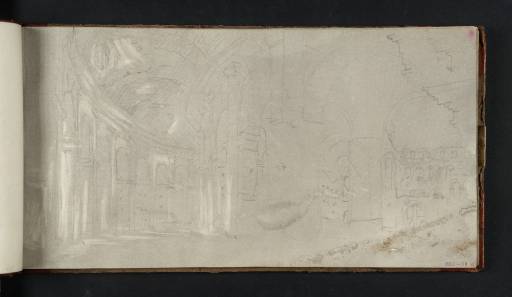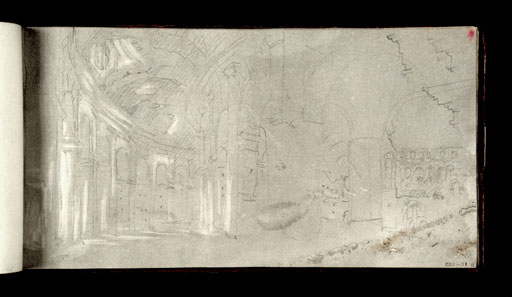Joseph Mallord William Turner Interior of the Colosseum, Rome 1819
Image 1 of 2
Joseph Mallord William Turner,
Interior of the Colosseum, Rome
1819
Joseph Mallord William Turner 1775–1851
Folio 18 Recto:
Interior of the Colosseum, Rome 1819
D16420
Turner Bequest CXC 18
Turner Bequest CXC 18
Pencil and grey watercolour wash on white wove paper, 130 x 255 mm
Inscribed by the artist in pencil ‘½’ and ‘2 ½’ and ‘1’ on column in foreground, centre right
Inscribed by ?John Ruskin with traces of red ink top right and by an unknown hand in pencil ‘18’ bottom right
Stamped in black ‘CXC 18’ bottom right
Inscribed by ?John Ruskin with traces of red ink top right and by an unknown hand in pencil ‘18’ bottom right
Stamped in black ‘CXC 18’ bottom right
Accepted by the nation as part of the Turner Bequest 1856
References
1909
A.J. Finberg, A Complete Inventory of the Drawings of the Turner Bequest, London 1909, vol.I, p.565, as ‘Do.[Ruins on the Palatine.]’.
1984
Cecilia Powell, ‘Turner on Classic Ground: His Visits to Central and Southern Italy and Related Paintings and Drawings’, unpublished Ph.D thesis, Courtauld Institute of Art, University of London 1984, p.428, as ‘Interior of the Colosseum’.
2008
Nicola Moorby, ‘Un tesoro italiano: i taccuini di Turner’, in James Hamilton, Nicola Moorby, Christopher Baker and others, Turner e l’Italia, exhibition catalogue, Palazzo dei Diamanti, Ferrara 2008, pp.102, 105 note 31.
2009
Nicola Moorby, ‘An Italian Treasury: Turner’s sketchbooks’, in James Hamilton, Nicola Moorby, Christopher Baker and others, Turner & Italy, exhibition catalogue, National Galleries of Scotland, Edinburgh 2009, pp.115, 155 note 32.
Arguably the most famous of all the surviving monuments of classical Rome is the Flavian Amphitheatre, a huge building universally known as the Colosseum, which stands at the eastern end of the Roman Forum between the Palatine and Esquiline Hills. Built 72–80 AD., the immense ruin was as popular with tourists during the eighteenth and nineteenth centuries as it is today and its crumbling but impressive remains represented a constant source of inspiration for artists. Turner’s 1819 sketches demonstrate that he studied the Colosseum from a variety of viewpoints both inside and outside the celebrated structure.1 He had read John Chetwode Eustace’s book, A Classical Tour Through Italy, which stated that ‘Never did human art present to the eye a fabric so well calculated by its size and form, to surprise and delight’ (see the Italian Guide Book sketchbook, Tate D13943; Turner Bequest CLXXII 7).2 Eustace recommended viewing the building first from the north, and then the south before finally entering its ‘lofty arcades’ to consider the ‘vast mass of ruin ... insulated walls, immense stones suspended in the air, arches covered with weeds and shrubs, vaults opening upon other ruins ... in short, above, below, and around, one vast collection of magnificence and devastation, of grandeur and decay’.3
This sketch depicts a view of part of the interior looking through towards the central arena from a section of the inner corridor. Like many drawings within this sketchbook, it has been executed over a washed grey background and Turner has created areas of pale highlights by rubbing or lifting through to the white paper beneath. The format of the composition, with its grand sweeping curve of arcade and dramatic contrasts of light and shade, was a popular theme amongst artists, reminiscent of Piranesi’s evocative treatment of Roman remains and his illustration of the interior of the Colosseum for the Vedute di Roma.4 A similar pictorial approach can be found in Joseph Wright of Derby, Inside the Arcade of the Colosseum circa 1774–5 (see Tate, T08590), John Robert Cozens, Interior of the Lower Ambulatory of the Colosseum 1778 (Private Collection),5 and John ‘Warwick’ Smith, An Arcade of the Colosseum (British Museum).6 Turner’s drawing, however, incorporates a more complex perspectival arrangement which further emphasises the scale and monumentality of the building.
Reproduced in colour in Eric Shanes, The Golden Age of Watercolours: The Hickman Bacon Collection, exhibition catalogue, Dulwich Picture Gallery 2001, no.2, p.20.
Verso:
Blank except for traces of grey and yellow ochre watercolour
Blank except for traces of grey and yellow ochre watercolour
Nicola Moorby
May 2009
How to cite
Nicola Moorby, ‘Interior of the Colosseum, Rome 1819 by Joseph Mallord William Turner’, catalogue entry, May 2009, in David Blayney Brown (ed.), J.M.W. Turner: Sketchbooks, Drawings and Watercolours, Tate Research Publication, December 2012, https://www


